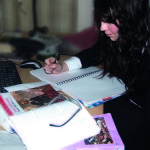Land Girls and Their Impact
by Ann Kramer (Remember When: Pen & Sword Books, 2009) paperback, rrp £14.99
Reviewed by Sue Johnson.
 Land Girls & Their Impact is a welcome addition to the history of this important service which was active in both world wars. The Women’s Land Army have been unsung heroines for far too long. This book, and their official government acknowledgement in December 2008, offers an overdue recognition of the important role played by members of the WLA in keeping the nation fed during wartime.
Land Girls & Their Impact is a welcome addition to the history of this important service which was active in both world wars. The Women’s Land Army have been unsung heroines for far too long. This book, and their official government acknowledgement in December 2008, offers an overdue recognition of the important role played by members of the WLA in keeping the nation fed during wartime.
Land Girls & Their Impact indicates that there is a wealth of resources with which to construct WLA history. Ann Kramer makes use of photographs, oral testimony, memoirs, diaries and the WLA magazine The Land Girl. She has also managed to gather a representative sample of WLA members so that the overall picture of life in this wartime occupation is varied and a lively history emerges which stretches back to World War One.
It is interesting to note that the notion of femininity and how to maintain it was one which troubled wartime planners in both wars. It was so problematic that Frederick Berlei was commissioned by the War Office during World War Two to create a supportive corset, to be worn by service women under their uniforms, which allowed just enough curve to be defined in order to maintain a feminine demeanour! (Chapter 3 also discusses other concerns and fears which abounded when women crossed the gender boundaries.) There was a belief that women were not strong enough to work on the land; this is illustrated in chapter 5 where WLA members recall that they were often expected to undertake domestic duties on farms until they made it clear that this was not their role. It was also feared that the lower rates paid to women workers would drive wages down for all; others felt it was unthinkable for a woman to drive a tractor. (Did no one consider what farmer’s wives and daughters had been doing?) For all these reasons, the Ministry of Agriculture pressed the Cabinet to postpone military service for male agricultural workers.
So, given the generally unwelcoming atmosphere and lack of glamour attached to the WLA , chapter 4 considers just Who were the Land Girls? Over 80,000 joined and all classes were represented. They were classed as civilians (so spared the Berlei corset!) and a range of reasons for joining are discussed. Again the fear of losing femininity emerges in the horror expressed by the mothers and husbands of some of the WLA who felt that for a woman, wearing trousers was `disgusting’.
Succeeding chapters reveal the similarities and differences experienced by the women and explain the work of a branch of the WLA often neglected by history, the Lumber Jills. Chapter 7 focuses on the lived experience of working on the land. For some young women it was their first time away from home. Their billets varied – some lived on the farm, some in hostels, some worked with a group of women, others were on their own. Some splendid memories of dreadful food are recalled, such as cold baked bean sandwiches or beetroot sandwiches, eaten outdoors, going red and soggy in the rain. This is countered by others remembering having hot drinks brought out to them in the winter, extra rations and delicious egg and watercress sandwiches. Unsurprisingly many seem unable to forget having to use the ditch as a loo!
Kramer has used the available evidence to give a splendid insight into life in the WLA in all its aspects. There is a variety of material published on the WLA but much, although not all, consists of one person’s memoirs or oral testimony, or books of photographs. Kramer has gathered together these differing aspects, rooted them in sound research and put this together in one volume. Despite a belief by some that WLA stood for Will Lie Anywhere or Will Love Anyone, in the later war years, largely due to their hard work, the women became more accepted. The early fears expressed about women working on the land came to nothing and the WLA helped to produce enough food so that Britain did not starve. To ensure that femininity remained in the forefront the WLA even organised beauty contests with pictures of the winners published in The Land Girl!
Land Girls and Their Impact, with its variety of experiences, begins to answer the question `What was it really like in the WLA?’ and is a welcome addition to our knowledge of women’s wartime work.










Leave a Reply